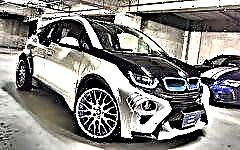

The content of the article:
- Modern electric cars
- European NEDC
- American EPA
- Japanese JC08
- World WLTC
At least 20 years ago, no one could have imagined that electric cars in the 2010s would begin to conquer the market and gain immense popularity. In many leading European countries, they provoke people to buy electric cars in every possible way. Following the popularity, competition among manufacturers also grows. Some try to attract with design and modern style, while others with technical characteristics.
Modern electric vehicles of the 21st century

Modern electric cars, in comparison with the first prototypes, are much different, firstly, in appearance, there are both unique and completely similar to ordinary cars. The power reserve has grown significantly, the average figure is about 100 km, although earlier the first copies barely reached the 50 km mark, and the latter is a price that is rapidly beginning to compete with cars based on an internal combustion engine.
Many buyers of electric vehicles primarily pay attention to the range, but what if different standards indicate different data for the same car? The difference in power reserve for the same electric vehicle can be 20-25%. According to the American EPA standard, the Nissan Leaf electric car will be able to travel 160 km, according to the European NEDC standard, the range is 175 km, and according to the Japanese measuring cycle JC08, the battery reserve is 200 km. There is another world WLTC standard for measuring power reserve, but the first three are the main and most popular standards today.
It is not difficult to notice that the same car shows different data. The Japanese standard shows the largest stock, but it is softer in its requirements and rules. The American standard is more demanding and strict in measurements, so the measurement result is much smaller. The average figures are shown by the European NEDC standard, since the average data of electric vehicles is taken as a basis.

For the CIS countries, the average indicator of the European and American standards is used. As many people know, the range of an electric car depends on the driving style, if it is operated carefully and slowly, then the data will be closer to the European standard, if you abandon the air conditioner and abrupt starts, then the indicators will be closer to the American standard. Initially, these standards were developed for conventional vehicles with an internal combustion engine, but as necessary they were modified and migrated to electric vehicles.
In addition to electric vehicles, they are also used to calculate the range of hybrid vehicles, but the figures are not so realistic to real conditions. But still, what is such a difference in the calculations of electric vehicles, in order to understand, we will consider each standard in more detail.
What is the European NEDC standard

The date of birth and the beginning of the use of the European standard NEDC (New European Driving Cycle) is January 1, 2000. The main condition for the European NEDC cycle is a distance of 11 kilometers, which must be covered in 20 minutes. Average speed for measurement is not more than 33.6 km / h. During the entire testing period, it is necessary to make 12 accelerations and the same number of stops. As many drivers say, the engineers of this European NEDC standard are careful to test electric vehicles that do not live up to real conditions.
Frozen European city range (Urban Driving Cycle), provides 4 different test cycles. Each such cycle of 195 seconds provides a distance of 1.013 kilometers. During testing, the electric car accelerates to speeds of 18, 32 and 50 km / h, and an average speed of 18.7 km / h. Measurement of the power reserve on the highway (Extra Urban Driving Cycle), in contrast to the urban version, provides for one measurement cycle. The distance is 6.955 km and must be covered in 400 seconds. The average speed of an electric car is 62.6 km / h, and the maximum should accelerate to 120 km / h. Nevertheless, the NEDC standard provides for its concessions. The first is turning off the main consumers of energy: turned off optics, turned off windshield wipers, audio system and air conditioning, in other words, ideal conditions for energy consumption are created. On the other hand, the acceleration of an electric car is slow and soft. To accelerate from 0 to 50 km / h, engineers according to the European NEDC standard took 26 seconds. For acceleration from zero to 70 km / h, 41 seconds are allocated, besides, the speeds on the highway are not so high.

As can be seen from the test cycles, the European NEDC standard is designed for leisurely Europeans in full compliance with the rules of movement. In the urban cycle, no more than 50 km / h, for the track, unhurried acceleration and observance of speed. Although comparing with our real rules, when the city is 60 km / h, but it is permissible +20 km / h (as a result, 70-80 km / h travel more often in the city), and this is almost 1.5 - 2 times more than declared in the European NEDC standard. Weather conditions are more stringent, especially in winter, when severe frosts and dark hours of the day are much longer - it pulls the frequent switching on of headlights, heated seats and heating of the interior.
In addition, the rhythm of movement is much more dynamic than in Europe. These are the main reasons why the European NEDC standard and its performance are slightly inconsistent with the real operating conditions of electric vehicles in our area. To achieve the stated data, you must try, observing the careful and accurate operation of the electric vehicle.
What is the American EPA Standard?

Compared to the previous standard, the American EPA (Environmental Protection Agency) cycle is more stringent in testing. The standard took its name from the organization that created it, a more accurate name FTP-75 (Federal Test Procedure 75). The first developments of the standard began back in 1978, but the most relevant revision in the direction of electric vehicles was presented in 2008.
The main value of the American EPA standard is considered to be versatility and vastness. The total testing time for an electric vehicle lasts 31 minutes at a distance of 17.8 km. During this period, the electric car makes 22 complete stops, followed by load acceleration. At the same time, the downtime is no more than 20% of the entire measuring cycle time, which is several times less than in the European NEDC cycle.
The average test speed of an electric vehicle according to the EPA standard is 35 km / h, but the maximum is no more than 91.2 km / h. Separately, there is a test cycle outside the city, where variable speed modes are assumed, and the average speed does not exceed 78 km / h. In addition to the standard EPA test options for an electric vehicle, separate measurements are provided. For example, the so-called US06, a sharp acceleration of an electric car from a traffic light, in a tough city stream. The second version of SC03 provides for a full load of electronics (meaning included optics, air conditioning, audio system, all kinds of heating) and tests in cold weather conditions.

We can say that these are the main virtues for which the American EPA cycle is respected by car manufacturers who want to show real opportunities. Realistically, it consists in fast movement, frequent start / stop, as in the urban cycle, acceleration dynamics and, of course, the full load on the electronics of the electric vehicle, including the air conditioner. Such unusual cycles show such a big difference between the European NEDC standard and the American EPA. But if you adhere to economical driving, and other rules, then the power reserve of an electric vehicle increases significantly.
What is the Japanese JC08 standard?

In early 2007, Japan announced a new standard for testing vehicle range, called JC08. Until 2010, there was another standard "10 * 15" in parallel, but since 2011, JC08 has remained the only standard in Japan. The duration of the Japanese standard JC08 is 1205 seconds, and the distance is only 8.17 km.
The average speed for measuring characteristics in the Japanese standard JC08 is 24.4 km / h, and the maximum speed is not more than 81.6 km / h. Compared to the previous two, the JC08's top priority is acceleration. It is also supposed to measure the data when starting on a cold and warm engine. Another nuance is stops with a total duration of about 30% of the entire JC08 cycle (considering that the entire cycle lasts about 20 minutes, the car is idle for 6 minutes). Given such conditions, it becomes clear where the large power reserve in an electric vehicle comes from.
The main task of the Japanese standard JC08 is to measure the parameters and power reserve in the urban cycle, driving in heavy traffic, traffic jams and acceleration over short distances. But the driving conditions on the highway at high speed are practically not taken into account, so the standard indicators are average.
What is the global WLTC standard for electric vehicles?

Taking into account the difference in the range of the same electric vehicle, relative to different standards, it was decided to create one common standard WLTC (WorldWide Harmonized Light Vehicles Test Cycle), which will be valid on all continents from 2017. This will allow you to compare the stock of an electric vehicle or the fuel consumption of a vehicle while adhering to the same cycle. On the other hand, the WLTC standard is quite strict. For measurements, engineers have allocated 30 minutes, and a distance of more than 23 km. Acceleration measurements will be the highest among all the named cycles.
For tests in the urban cycle, the electric vehicle accelerates to speeds of 56.5 km / h and 76.6 km / h, so two results and one average will be obtained. Similarly, measurements are made for driving on the highway, the first time the acceleration will be up to 97.4 km / h, and the second time up to 131.6 km / h. The result is a fast and dynamic ride for different countries and conditions. Another main direction is the division into classes, eco-modes and a couple of non-standard conditions, which are as close as possible to realistic vehicle operating conditions (ambient temperature, weather conditions and terrain).
For hybrids, the WLTC standard provides for separate conditions, the battery must be fully charged, otherwise the company representatives will not be able to prove the declared characteristics. If the charge changes during testing, then subtract or add kWh, respectively. In the case where the hybrid is recharged, the WLTC standard provides for 4 different cycles. The first is when the battery is fully discharged, the second and third with partially discharged batteries, and the 4th hybrid cycle in EV mode.

For electric cars, a completely different package of conditions, first of all, the battery is fully charged within 12 hours, and for Tesla, where a full charge is much longer, they can set their own conditions. Engineers of the WLTC standard suggest revision, since the tendency to increase the battery capacity of electric vehicles is growing every year. But there are also nuances, with which charging will bring 100% battery charge, since different countries use different charges. For example, standard charging can bring the battery up to 80%, but what about the remaining 20% is not yet known. In general, this world WLTC standard is still being finalized and with regard to electric vehicles they want to highlight completely separate requirements. The first to be tested will be the Opel Ampera-e 2017 electric car, which was presented at the Paris Auto Show, and the power reserve is enough for 500 km.
In general, the standards are varied, but each has both pros and cons. For the most part, they especially rely on the European standard NEDC and the American EPA, since they are closer to the conditions where the vehicle will be used, but still you should not completely rely on the data of these standards.











